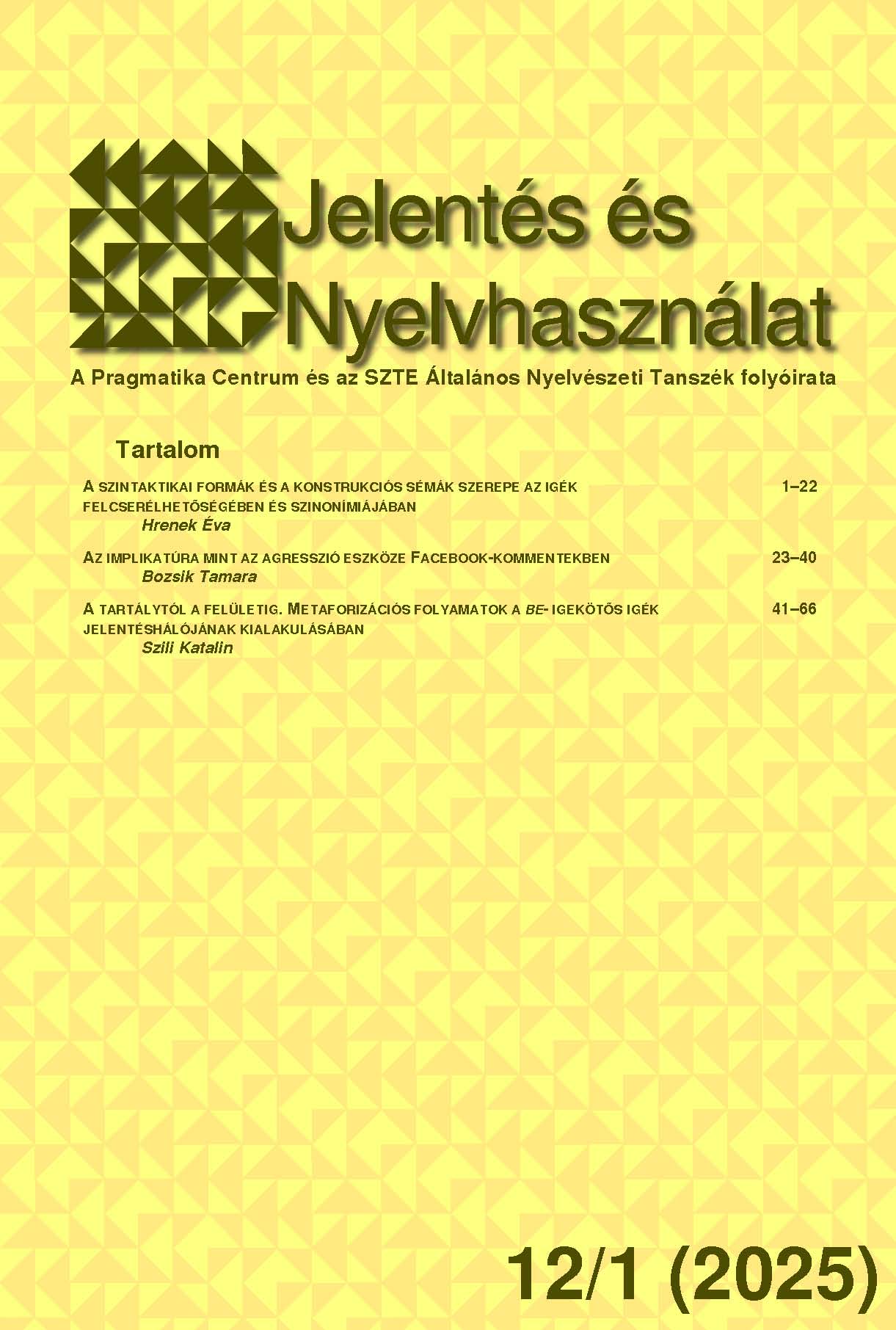Verbal politeness strategy preferences in autism spectrum condition
Main Article Content
Abstract
This study focuses on the preferences of autistic adults (level 1 „requiring support”, N = 12) and non-autistic adults (N = 12) regarding their use of verbal politeness strategies. The research examines a) what politeness strategies the two subject groups employ to minimize the impact of various types of threats to their own or their partner’s face, and b) whether their preferences change depending on the level of formality in the relationship between the conversational partners.
Results: both groups show similar preferences for politeness strategies, and favor on-record strategies, expressing their intentions. They follow the general principle of rationality, while considering the social context.
Relations between autistic behavioral characteristics and preferences for politeness strategies support the assumption that face-saving acts and the use of indirect utterances presuppose certain social and cognitive skills, but that conventionalized forms can be learnt regardless of these skills.
Downloads
Article Details

This work is licensed under a Creative Commons Attribution-NonCommercial-NoDerivatives 4.0 International License.
References
[APA] 2013. Diagnostic and Statistical Manual of Mental Disorders. 5. kiadás. American Psychiatric Association. https://doi.org/10.1176/appi.books.9780890425596.
Bargiela, Sarah – Robyn Steward – William Mandy 2016. The experiences of late-diagnosed women with autism spectrum conditions: An investigation of the female autism phenotype. Journal of Autism and Developmental Disorders 46/10:3281–3294. https://doi.org/10.1007/s10803-016-2872-8.
Baron-Cohen, Simon – Sally Wheelwright – Richard Skinner – Joanne Martin – Emma Clubley 2001. The Autism-Spectrum Quotient (AQ): Evidence from Asperger syndrome/high-functioning autism, males and females, scientists and mathematicians. Journal of Autism and Developmental Disorders 31/1:5–17. https://doi.org/10.1023/A:1005653411471.
Belek, Ben 2018. Autism and the proficiency of social ineptitude: Probing the rules of “appropriate” behavior. Ethos 46/2:161–179. https://doi.org/10.1111/etho.12202.
Bottema-Beutel, Kristen – Steven K. Kapp – Jessica Nina Lester – Noah J. Sasson – Brittany N. Hand 2021. Avoiding ableist language: Suggestions for autism researchers. Autism in Adulthood 3/1:18–29. https://doi.org/10.1089/aut.2020.0014.
Brown, Penelope – Stephen C. Levinson 1987. Politeness. Some Universals in Language Usage. Cambridge: Cambridge University Press.
Brown, Penelope – Stephen C. Levinson 2008 [1978]. Univerzálék a nyelvhasználatban: az udvariasság jelenségei (ford. Síklaki István). In Síklaki István (szerk.) Szóbeli befolyásolás II. Nyelv és szituáció. Budapest: Typotex Kiadó. 37–118.
Cook, Julia – Laura Crane – Laura Bourne – Laura Hull – William Mandy 2021. Camouflaging in an everyday social context: An interpersonal recall study. Autism 25/5:1444–1456. https://doi.org/10.1177/1362361321992641.
Fletcher-Watson, Sue – Francesca Happé 2019. Autism. A New Introduction to Psychological Theory and Current Debate. Routledge.
Goffman, Erving 2008 [1967]. A homlokzatról. In Síklaki István (szerk.) Szóbeli befolyásolás II. Nyelv és szituáció. Budapest: Typotex Kiadó. 11–36.
Grandin, Temple – Sean Barron 2019. The Unwritten Rules of Social Relationships. Arlington: Future Horizons.
Grice, H. Paul 1975. Logic and conversation. In Peter Cole – Jerry L. Morgan (szerk.) Syntax and Semantics Vol. 3. Speech Acts. New York: Academic Press. 41–58.
Győri Miklós 2014. A nyelv, a kommunikáció és a megismerés atipikus mintázatai és kapcsolatai autizmus spektrum zavarokban. In Pléh Csaba – Lukács Ágnes (szerk.) Pszicholingvisztika. Magyar pszicholingvisztikai kézikönyv. Budapest: Akadémiai Kiadó. 1345–1382.
Happé, Francesca G. E. 1993. Communicative competence and theory of mind in autism: A test of relevance theory. Cognition 48/2:101–119. https://doi.org/10.1016/0010-0277(93)90026-R.
Howlin, Patricia 2001. Autizmus. Felkészülés a felnőttkorra. Budapest: Kapocs Könyvkiadó.
Ivaskó Lívia 2005. Félreértéseink nyomában. In Ivaskó Lívia (szerk.) Érthető kommunikáció. Szeged: SZTE Médiatudományi Tanszék. 14–26.
Koskinen, Emmi – Melisa Stevanovic – Anssi Peräkylä 2021. The recognition and interactional management of face threats: Comparing neurotypical participants and participants with Asperger’s syndrome. Social Psychology Quarterly 84/2:132–154. https://doi.org/10.1177/01902725211003023.
Mezőlaki Regina 2024. Autista felnőttek és autista személyekkel foglalkozó szakemberek a sikeres kommunikációról. In Bajzát Tímea Borbála – Hauber Kitti – K. Molnár Emese – Kopcsák Róbert – Mayer Péter – Turcsik Bíborka (szerk.) Nyelvek és nézőpontok. Tanulmányok a 17. és 18. Félúton konferenciáról. Budapest: ELTE BTK. 39–54.
Mezőlaki Regina – Ivaskó Lívia 2019. Felnőtt neurotipikus és autista személyek közötti társas interakciós konfliktushelyzetek kezelésének sajátosságai. Argumentum 15:738–754. https://doi.org/10.34103/ARGUMENTUM/2019/3.
Mezőlaki, Regina – Lívia Ivaskó 2024. Accepted boundaries for barrier-free communication between autistic adults and non-autistic professionals. Argumentum 20:165–181. https://doi.org/10.34103/ARGUMENTUM/2024/9.
Milton, Damian E. M. 2012. On the ontological status of autism: the ‘double empathy problem’. Disability & Society 27/6:883–887. https://doi.org/10.1080/09687599.2012.710008.
Milton, Damian E. M. 2018. The double empathy problem. Weboldal. National Autistic Society. https://www.autism.org.uk/advice-and-guidance/professional-practice/double-empathy [2025. június 26.].
Nemesi Attila László 2011. Nyelv, nyelvhasználat, kommunikáció. Budapest: Loisir Kiadó.
Ochs, Elinor – Tamar Kremer-Sadlik – Karen Gainer Sirota – Olga Solomon 2004. Autism and the social world: An anthropological perspective. Discourse Studies 6/2:147–183. https://doi.org/10.1177/1461445604041766.
Perkins, Lisa – Lesley Milroy 1997. Sharing the communicative burden: A conversation-analytic account of aphasic/non-aphasic interaction. Multilingua 16/2–3:199–216. https://doi.org/10.1515/mult.1997.16.2-3.199.
Sifianou, Maria – Angeliki Tzanne 2021. Face, facework and face-threatening acts. In Michael Haugh – Dániel Z. Kádár – Marina Terkourafi (szerk.) The Cambridge Handbook of Sociopragmatics. Cambridge Handbooks in Language and Linguistics. Cambridge: Cambridge University Press. 249–271. https://doi.org/10.1017/9781108954105.015.
Sirota, Karen Gainer 2004. Positive politeness as discourse process: politeness practices of high-functioning children with autism and Asperger syndrome. Discourse Studies 6/2:229–251. https://doi.org/10.1177/1461445604041769.
Szili Katalin 2007. Az udvariasság pragmatikája. Magyar Nyelvőr 131/1:1–17.

